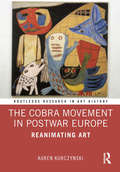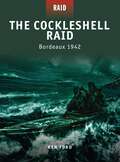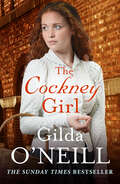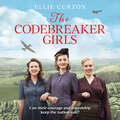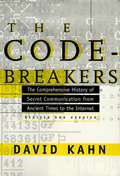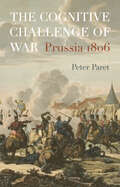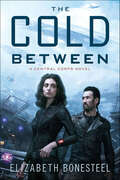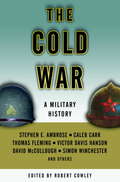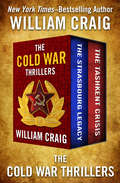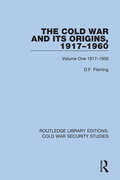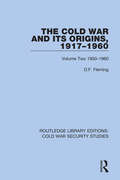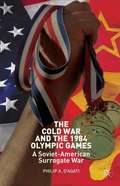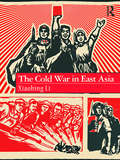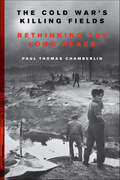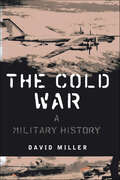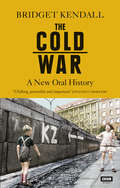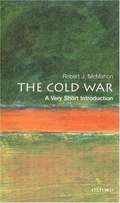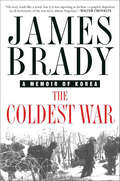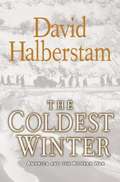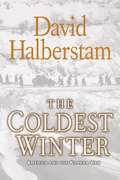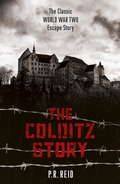- Table View
- List View
The Cobra Movement in Postwar Europe: Reanimating Art (Routledge Research in Art History)
by Karen KurczynskiThis book examines the art of Cobra, a network of poets and artists from Copenhagen, Brussels, and Amsterdam (1948–1951). Although the name stood for the organizers’ home cities, the Cobra artists hailed from countries in Europe, Africa, and the United States. This book investigates how a group of struggling young artists attempted to reinvent the international avant-garde after the devastation of the Second World War, to create artistic experiments capable of facing the challenges of postwar society. It explores how Cobra’s experimental, often collective art works and publications relate to broader debates in Europe about the use of images to commemorate violent events, the possibility of free expression in an art world constrained by Cold War politics, the breakdown of primitivism in an era of colonial independence movements, and the importance of spontaneity in a society increasingly dominated by the mass media. This book will be of interest to scholars in art history, 20th-century modern art, avant-garde arts, and European history.
The Cockleshell Raid: Bordeaux 1942
by Howard Gerrard Ken FordOn the night of December 7, 1942, five canoes were launched off the mouth of the Gironde river, each containing a pair of British commandoes tasked with slipping into the port of Bordeaux and destroying as many of the merchant ships as possible. Only two of the canoes made it to the target, but it was enough. Five enemy ships were badly damaged in the attack. It then became a game of cat and mouse for the surviving commandoes in their attempt to get back to Britain. Some of the men made it to Gibraltar; others were caught and executed. Author Ken Ford gives a blow-by-blow account of one of the most daring raids of World War II, which badly upset the flow of material into Germany, and which gave the British public a much needed victory.
The Cockney Girl
by Gilda O'NeillAn East End mother and daughter travel from London to work the hop fields of Kent in this gripping saga of love and loss on the eve of the Great War. The annual migration from London to the hop fields of Kent is normally a longed-for escape from the dust and grime of the East End. But this year Rose Fairleigh worries their departure will interrupt the slow-blossoming romance between her daughter Jess and postman Jack Barnes. Jack promises to visit and assures Rose he will keep an eye on her three sons, who are staying behind. Before he knows it, though, one of the boys is in trouble and it&’s up to Jack to bring him home. Meanwhile in Kent, Jess&’ life grows increasingly confusing as, full of promises and charm, the son of suffragette Lady Worlington turns his attentions to her . . . A heart-wrenching East End family drama, perfect for fans of Sheila Newberry and Downton Abbey.
The Codebreaker Girls
by Ellie Curzon'Saga lovers will really enjoy this book and i look forward to more' NetGalley reviewer'What a fantastic read. This book pulled me in from the get go, so naturally was finished in one sitting' NetGalley reviewer1944. Rosie Sinclair is full of pride to be doing her bit for the war effort as a driver at Cottisbourne Park - the secret heart of Britain's fight against Germany, where a team of brilliant and eccentric codebreakers are battling to save the country.But when she's given a new mission to drive Major-General 'Bluff' Kingsley-Flynn down to Cottisbourne, Rosie finds herself on the frontline of a new battle - to uncover a possible spy at the Park who is jeopardising their vital work, and to resist her own growing attraction to the dashing Bluff himself...As the threat to her fellow codebreaker girls grows ever stronger, Rosie realises her country needs her more than ever. Can she save the day without losing her heart?A heartwarming, funny and utterly charming World War II saga, perfect for fans of Kate Hewitt, Jenny Holmes and Annie Murray.
The Codebreaker Girls
by Ellie CurzonIt's 1944, and Rosie Sinclair is full of pride to be doing her bit for the war effort as a driver at Cottisbourne Park - the secret heart of Britain's fight against Germany, where a team of brilliant and eccentric codebreakers are battling to save the country.But when she's given a new mission to drive Major-General 'Bluff' Kingsley-Flynn down to Cottisbourne, Rosie finds herself on the frontline of a new battle - to uncover a possible spy at the Park who is jeopardising their vital work, and to resist her own growing attraction to the dashing Bluff himself...As the threat to her fellow codebreaker girls grows ever stronger, Rosie realises her country needs her more than ever. Can she save the day without losing her heart?A heartwarming, funny and utterly charming World War II saga, perfect for fans of Kate Hewitt, Jenny Holmes and Annie Murray.
The Codebreaker Girls
by Ellie Curzon1944. Rosie Sinclair is full of pride to be doing her bit for the war effort as a driver at Cottisbourne Park - the secret heart of Britain's fight against Germany, where a team of brilliant and eccentric codebreakers are battling to save the country. But when she's given a new mission to drive Major-General 'Bluff' Kingsley-Flynn down to Cottisbourne, Rosie finds herself on the frontline of a new battle - to uncover a possible spy at the Park who is jeopardising their vital work, and to resist her own growing attraction to the dashing Bluff himself... As the threat to her fellow codebreaker girls grows ever stronger, Rosie realises her country needs her more than ever. Can she save the day without losing her heart? A heartwarming, funny and utterly charming World War II saga, perfect for fans of Kate Hewitt, Jenny Holmes and Annie Murray.
The Codebreaker's Secret: A WWII Novel
by Sara Ackerman"Sara Ackerman never disappoints!" —Kate Quinn, New York Times bestselling author of The Rose Code"Brilliantly written with a mystery that will keep you reading late into the night. . . . A fabulous read that makes me want to drop everything and travel to Hawaii!" —Madeline Martin, New York Times bestselling author of The Last Bookshop in LondonA brilliant female codebreaker. An &“unbreakable&” Japanese naval code. A pilot on a top-secret mission that could change the course of WWII. The Codebreaker's Secret is a dazzling story of love and intrigue set during America&’s darkest hour.1943. As war in the Pacific rages on, Isabel Cooper and her codebreaker colleagues huddle in &“the dungeon&” at Station HYPO in Pearl Harbor, deciphering secrets plucked from the airwaves in a race to bring down the enemy. Isabel has only one wish: to avenge her brother&’s death. But she soon finds life has other plans when she meets his best friend, a hotshot pilot with secrets of his own.1965. Fledgling journalist Lu Freitas comes home to Hawai'i to cover the grand opening of the glamorous Mauna Kea Beach Hotel, Rockefeller's newest and grandest project. When a high-profile guest goes missing, Lu forms an unlikely alliance with an intimidating veteran photographer to unravel the mystery. The two make a shocking discovery that stirs up memories and uncovers an explosive secret from the war days. A secret that only a codebreaker can crack.Don't miss THE GUEST IN ROOM 120, Sara Ackerman's enthralling new novel with dual-timelines intertwining a 1905 mystery surrounding Jane Stanford's mysterious death in Honolulu and a 2005 writer's quest to uncover the truth at the same historic hotel...More captivating stories from Sara Ackerman: The Maui Effect The Unchartered Flight of Olivia West Radar Girls Red Sky Over Hawaii The Lietenant's Nurse Island of Sweet Pies & Soldiers
The Codebreakers: The Comprehensive History of Secret Communication from Ancient Times to the Internet
by David KahnThe magnificent, unrivaled history of codes and ciphers -- how they're made, how they're broken, and the many and fascinating roles they've played since the dawn of civilization in war, business, diplomacy, and espionage -- updated with a new chapter on computer cryptography and the Ultra secret. Man has created codes to keep secrets and has broken codes to learn those secrets since the time of the Pharaohs. For 4,000 years, fierce battles have been waged between codemakers and codebreakers, and the story of these battles is civilization's secret history, the hidden account of how wars were won and lost, diplomatic intrigues foiled, business secrets stolen, governments ruined, computers hacked. From the XYZ Affair to the Dreyfus Affair, from the Gallic War to the Persian Gulf, from Druidic runes and the kaballah to outer space, from the Zimmermann telegram to Enigma to the Manhattan Project, codebreaking has shaped the course of human events to an extent beyond any easy reckoning. Once a government monopoly, cryptology today touches everybody. It secures the Internet, keeps e-mail private, maintains the integrity of cash machine transactions, and scrambles TV signals on unpaid-for channels. David Kahn's The Codebreakers takes the measure of what codes and codebreaking have meant in human history in a single comprehensive account, astonishing in its scope and enthralling in its execution. Hailed upon first publication as a book likely to become the definitive work of its kind, The Codebreakers has more than lived up to that prediction: it remains unsurpassed. With a brilliant new chapter that makes use of previously classified documents to bring the book thoroughly up to date, and to explore the myriad ways computer codes and their hackers are changing all of our lives, The Codebreakers is the skeleton key to a thousand thrilling true stories of intrigue, mystery, and adventure. It is a masterpiece of the historian's art.
The Cognitive Challenge of War: Prussia 1806
by Peter ParetThe compelling story of the military campaign that changed how we think about warResponding to the enemy's innovation in war presents problems to soldiers and societies of all times. This book traces Napoleon's victory over Prussia in 1806 and Prussia's effort to recover from defeat to show how in one particular historical episode operational analyses together with institutional and political decisions eventually turned defeat to victory.The author moves from a comparative study of French and Prussian forces to campaign narrative and strategic analysis. He examines processes of change in institutions and doctrine, as well as their dependence on social and political developments, and interprets works of art and literature as indicators of popular and elite attitudes toward war, which influence the conduct of war and the kind and extent of military innovation. In the concluding chapter he addresses the impact of 1806 on two men who fought on opposing sides in the campaign and sought a new theoretical understanding of war—Henri Jomini and Carl von Clausewitz.Fields of history that are often kept separate are brought together in this book, which seeks to replicate the links between different areas of thought and action as they exist in reality and shape events.
The Cold Between: A Central Corps Novel
by Elizabeth BonesteelFrom debut author Elizabeth Bonesteel, The Cold Between is the start to a stellar military science fiction series that combines hints of mystery and romance with action and adventure in the tradition of Elizabeth Moon, Linnea Sinclair, and Lois McMaster Bujold.When her crewmate, Danny, is murdered on the colony of Volhynia, Central Corps chief engineer, Commander Elena Shaw, is shocked to learn the main suspect is her lover, Treiko Zajec. She knows Trey is innocent—he was with her when Danny was killed. So who is the real killer and why are the cops framing an innocent man?Retracing Danny’s last hours, they discover that his death may be tied to a mystery from the past: the explosion of a Central Corps starship at a wormhole near Volhynia. For twenty-five years, the Central Gov has been lying about the tragedy, even willing to go to war with the outlaw PSI to protect their secrets.With the authorities closing in, Elena and Trey head to the wormhole, certain they’ll find answers on the other side. But the truth that awaits them is far more terrifying than they ever imagined . . . a conspiracy deep within Central Gov that threatens all of human civilization throughout the inhabited reaches of the galaxy—and beyond.
The Cold War
by Robert CowleyEven fifteen years after the end of the Cold War, it is still hard to grasp that we no longer live under its immense specter. For nearly half a century, from the end of World War II to the early 1990s, all world events hung in the balance of a simmering dispute between two of the greatest military powers in history. Hundreds of millions of people held their collective breath as the United States and the Soviet Union, two national ideological entities, waged proxy wars to determine spheres of influence–and millions of others perished in places like Korea, Vietnam, and Angola, where this cold war flared hot. Such a consideration of the Cold War–as a military event with sociopolitical and economic overtones–is the crux of this stellar collection of twenty-six essays compiled and edited by Robert Cowley, the longtime editor of MHQ: The Quarterly Journal of Military History. Befitting such a complex and far-ranging period, the volume’s contributing writers cover myriad angles. John Prados, in “The War Scare of 1983,” shows just how close we were to escalating a war of words into a nuclear holocaust. Victor Davis Hanson offers “The Right Man,” his pungent reassessment of the bellicose air-power zealot Curtis LeMay as a man whose words were judged more critically than his actions. The secret war also gets its due in George Feiffer’s “The Berlin Tunnel,” which details the charismatic C. I. A. operative “Big Bill” Harvey’s effort to tunnel under East Berlin and tap Soviet phone lines–and the Soviets’ equally audacious reaction to the plan; while “The Truth About Overflights,” by R. Cargill Hall, sheds light on some of the Cold War’s best-kept secrets. The often overlooked human cost of fighting the Cold War finds a clear voice in “MIA” by Marilyn Elkins, the widow of a Navy airman, who details the struggle to learn the truth about her husband, Lt. Frank C. Elkins, whose A-4 Skyhawk disappeared over Vietnam in 1966. In addition there are profiles of the war’s “front lines”–Dien Bien Phu, the Cuban Missile Crisis, the Bay of Pigs–as well as of prominent military and civil leaders from both sides, including Harry S. Truman, Nikita Khrushchev, Dean Acheson, Gen. Douglas MacArthur, Richard M. Nixon, Gen. Vo Nguyen Giap, and others. Encompassing so many perspectives and events,The Cold Warsucceeds at an impossible task: illuminating and explaining the history of an undeclared shadow war that threatened the very existence of humankind. From the Hardcover edition.
The Cold War Thrillers: The Strasbourg Legacy and The Tashkent Crisis
by William J. CraigTwo explosive novels set in the perilous days when the world stood on the brink of chaos—from the New York Times–bestselling author of Enemy at the Gates. For almost fifty years after World War II, the United States and the Soviet Union played a dangerous game in the shadows. And from those shadows would emerge unsung heroes who would fight for freedom . . . The Strasbourg Legacy: Investigating the possible Soviet theft of US munitions, CIA agent Matt Corcoran hears rumors that German communists and Aryan terrorists are conspiring to assassinate political leaders. But far more ominous is the underground cadre of surviving Nazi officers bent on starting the Fourth Reich . . . The Tashkent Crisis: As tensions rise between the superpowers, the Soviets deliver an ultimatum: surrender unconditionally or a devastating secret weapon will kill millions of Americans. Now a Special Forces team led by Col. Joe Safcek must infiltrate a secret Soviet base and destroy the mystery weapon. But the closer they get, the more Safcek realizes it may already be too late . . . With these &“furious-paced&” novels of &“timeclock suspense&” William Craig takes readers back to a time when the Cold War could have started burning with a single spark (Kirkus Reviews).
The Cold War and its Origins, 1917-1960: Volume One 1917-1950 (Routledge Library Editions: Cold War Security Studies #13)
by D.F. FlemingThis book, first published in 1961, is an analysis of the great struggle of the twentieth century, the Cold War. It carefully examines the conflict’s origins in the Russian Revolution of 1917, and follows the thread of antagonism between west and east all the way up to 1960. These were the key years of the Cold War, when it seemed that the prospect of nuclear confrontation was a real one, and this book offers a close reading of the main events of those years. This volume concentrates on the European theatre, and Volume Two focuses on the Cold War in the East.
The Cold War and its Origins, 1917-1960: Volume Two 1950-1960 (Routledge Library Editions: Cold War Security Studies #14)
by D.F. FlemingThis book, first published in 1961, is an analysis of the great struggle of the twentieth century, the Cold War. It carefully examines the conflict’s origins in the Russian Revolution of 1917, and follows the thread of antagonism between west and east all the way up to 1960. These were the key years of the Cold War, when it seemed that the prospect of nuclear confrontation was a real one, and this book offers a close reading of the main events of those years. This volume concentrates on the Cold War in the East, and Volume One focuses on the European theatre.
The Cold War and the 1984 Olympic Games
by Philip D’agatiThe Soviet boycott of the 1984 Olympic Games is explained as the result of a complex series of events and policies that culminated in a strategic decision to not participate in Los Angeles. Using IR framework, D'Agati developes and argues for the concept of surrogate wars as an alternative means for conflict between states.
The Cold War in East Asia
by Xiaobing LiThis textbook provides a survey of East Asia during the Cold War from 1945 to 1991. Focusing on the persistence and flexibility of its culture and tradition when confronted by the West and the US, this book investigates how they intermesh to establish the nations that have entered the modern world. Through the use of newly declassified Communist sources, the narrative helps students form a better understanding of the origins and development of post-WWII East Asia. The analysis demonstrates how East Asia’s position in the Cold War was not peripheral but, in many key senses, central. The active role that East Asia played, ultimately, turned this main Cold War battlefield into a "buffer" between the United States and the Soviet Union. Covering a range of countries, this textbook explores numerous events, which took place in East Asia during the Cold War, including: The occupation of Japan, Civil war in China and the establishment of Taiwan, The Korean War, The Vietnam War, China’s Reforming Movement. Moving away from Euro-American centric approaches and illuminating the larger themes and patterns in the development of East Asian modernity, The Cold War in East Asia is an essential resource for students of Asian History, the Cold War and World History.
The Cold War in the Middle East: Regional Conflict and the Superpowers 1967-73 (Cold War History Ser.)
by Nigel J. AshtonThis edited volume re-assesses the relationship between the United States, the Soviet Union and key regional players in waging and halting conflict in the Middle East between 1967 and 1973. These were pivotal years in the Arab-Israeli conflict, with the effects still very much in evidence today. In addition to addressing established debates, the bo
The Cold War's Killing Fields: Rethinking the Long Peace
by Paul Thomas ChamberlinThis sweeping, international military history boldly reframes the Cold War as one of the three great conflicts of the twentieth century.The Cold War has long been viewed as a tense diplomatic standoff between global superpowers representing democracy and communism. Yet it fostered a series of deadly conflicts on battlegrounds across the postcolonial world. For half a century, as an uneasy accord hung over Europe, ferocious wars raged in the Cold War’s killing fields, resulting in more than fourteen million dead—victims who remain largely forgotten and all but lost to history. A superb work of scholarship, The Cold War’s Killing Fields is the first global military history of this conflict and the first full accounting of its devastating impact. More than previous armed conflicts, the wars of the post-1945 era ravaged civilians across vast stretches of territory, from Korea and Vietnam to Bangladesh and Afghanistan to Iraq and Lebanon. Chamberlin provides an understanding of this sweeping history from the ground up and offers a moving portrait of human suffering, capturing the voices of those who experienced the brutal warfare.Chamberlin explores in detail the numerous battles fought to prevent nuclear war, bolster the strategic hegemony of the United States and the USSR, and determine the fates of societies throughout the Third World.
The Cold War: A Military History
by David MillerIn The Cold War: A Military History, David Miller, a preeminent Cold War scholar, writes insightfully of the historic effects of the military build-up brought on by the Cold War and its concomitant effect on strategy. Bringing together for the first time newly declassified information, Miller takes readers inside the arsenals of the superpowers, describing how intercontinental ballistic missiles, submarine-based missiles, strategic bombers, and conventional weapons were employed by both sides, as well as the ways in which they were, at many points, almost brought to bear. His in-depth analysis of how military strategy shaped history, and his accounts of crises which could have turned the Cold War hot--the suppression of the Budapest uprising in 1956, and the imposition of martial law in Poland in 1981--are particularly compelling. Many books have been written about the politics in this turbulent period, but none have so comprehensively examined the military strategy and tactics of this dangerous era.
The Cold War: A New Oral History of Life Between East and West
by Bridget KendallThe Cold War is one of the furthest-reaching and longest-lasting conflicts in modern history. It spanned the globe - from Greece to China, Hungary to Cuba - and lasted for almost half a century. It has shaped political relations to this day, drawing new physical and ideological boundaries between East and West. In this meticulously researched account, Bridget Kendall explores the Cold War through the eyes of those who experienced it first-hand. Alongside in-depth analysis that explains the historical and political context, the book draws on exclusive interviews with individuals who lived through the conflict's key events, offering a variety of perspectives that reveal how the Cold War was experienced by ordinary people. From pilots making food drops during the Berlin Blockade and Japanese fishermen affected by H-bomb testing to families fleeing the Korean War and children whose parents were victims of McCarthy's Red Scare, The Cold War covers the full geographical and historical reach of the conflict. The Cold War is essential reading for anyone seeking to understand how the tensions of the last century have shaped the modern world, and what it was like to live through them.
The Cold War: A Very Short Introduction
by Robert J. McmahonThe massive disorder and economic ruin following the Second World War inevitably predetermined the scope and intensity of the Cold War. But why did it last so long? And what impact did it have on the United States, the Soviet Union, Europe, and the Third World? Finally, how did it affect the broader history of the second half of the twentieth century - what were the human and financial costs? This Very Short Introduction provides a clear and stimulating interpretive overview of the Cold War, one that will both invite debate and encourage deeper investigation.
The Coldest War: A Memoir of Korea
by James BradyJames Brady's The Coldest War is a powerful and moving memoir of the Korean War. America's "forgotten war" lasted just thirty-seven months, yet 54,246 Americans died in that time -- nearly as many as died in ten years in Vietnam. On the fiftieth anniversary of this devastating conflict, James Brady tells the story of his life as a young marine lieutenant in Korea.In 1947, seeking to avoid the draft, nineteen-year-old Jim Brady volunteered for a Marine Corps program that made him a lieutenant in the reserves on the day he graduated college. He didn't plan to find himself in command of a rifle platoon three years later facing a real enemy, but that is exactly what happened after the Chinese turned a so-called police action into a war.The Coldest War vividly describes Brady's rapid education in the realities of war and the pressures of command. Opportunities for bold offensives sink in the miasma of trench warfare; death comes in fits and starts as too-accurate artillery on both sides seeks out men in their bunkers; constant alertness is crucial for survival, while brutal cold and a seductive silence conspire to lull soldiers into an often fatal stupor.The Korean War affected the lives of all Americans, yet is little known beyond the antics of "M*A*S*H." Here is the inside story that deserves to be told, and James Brady is a powerful witness to a vital chapter of our history.
The Coldest Winter: America and the Korean War
by David HalberstamA masterful narrative of the political decisions and missteps on both sides with nuanced portraits of all the major figures of the war
The Coldest Winter: America and the Korean War
by David Halberstam"In a grand gesture of reclamation and remembrance, Mr. Halberstam has brought the war back home."--The New York TimesDavid Halberstam's magisterial and thrilling The Best and the Brightest was the defining book about the Vietnam conflict. More than three decades later, Halberstam used his unrivaled research and formidable journalistic skills to shed light on another pivotal moment in our history: the Korean War. Halberstam considered The Coldest Winter his most accomplished work, the culmination of forty-five years of writing about America's postwar foreign policy.Halberstam gives us a masterful narrative of the political decisions and miscalculations on both sides. He charts the disastrous path that led to the massive entry of Chinese forces near the Yalu River and that caught Douglas MacArthur and his soldiers by surprise. He provides astonishingly vivid and nuanced portraits of all the major figures-Eisenhower, Truman, Acheson, Kim, and Mao, and Generals MacArthur, Almond, and Ridgway. At the same time, Halberstam provides us with his trademark highly evocative narrative journalism, chronicling the crucial battles with reportage of the highest order. As ever, Halberstam was concerned with the extraordinary courage and resolve of people asked to bear an extraordinary burden.The Coldest Winter is contemporary history in its most literary and luminescent form, providing crucial perspective on every war America has been involved in since. It is a book that Halberstam first decided to write more than thirty years ago and that took him nearly ten years to complete. It stands as a lasting testament to one of the greatest journalists and historians of our time, and to the fighting men whose heroism it chronicles.
The Colditz Story
by Major P ReidColditz was the last stop for prisoners of war during WWII. Those who persisted in escaping from other camps were sent to the impregnable fortress of Colditz Castle, situated on a rocky outcrop high above the River Mulde. Once within the walls of the castle, the Germans reasoned, escape was impossible. And yet many prisoners attempted escape and many succeeded Pat Reid was one of those men. Appointed 'Escape Officer' by his fellow inmates, he masterminded many of the attempts. From tunnelling, to hiding in rubbish sacks, disguising themselves as German officers and even leaping from the castle walls, nothing was too dangerous or foolhardy compared to imprisonment by the enemy. Reid's own escape, in 1942, was both one of the most simple and the most daring. First published in 1952, The Colditz Story is a classic escape story in the tradition of The Great Escape and The Wooden Horse.
